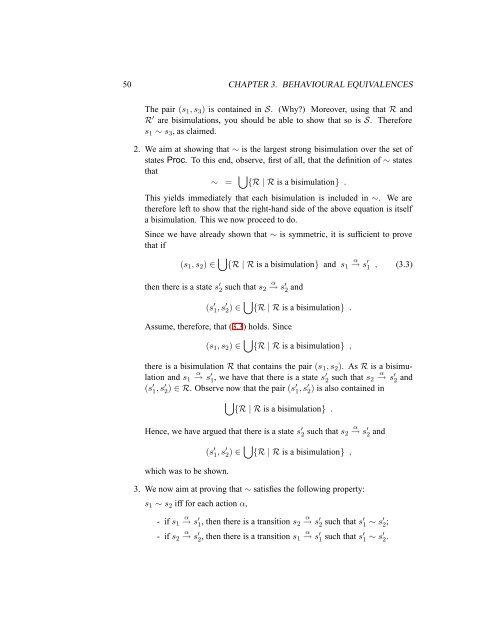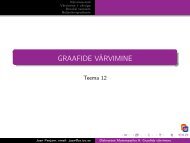Reactive Systems: Modelling, Specification and Verification - Cs.ioc.ee
Reactive Systems: Modelling, Specification and Verification - Cs.ioc.ee
Reactive Systems: Modelling, Specification and Verification - Cs.ioc.ee
Create successful ePaper yourself
Turn your PDF publications into a flip-book with our unique Google optimized e-Paper software.
50 CHAPTER 3. BEHAVIOURAL EQUIVALENCES<br />
The pair (s1, s3) is contained in S. (Why?) Moreover, using that R <strong>and</strong><br />
R ′ are bisimulations, you should be able to show that so is S. Therefore<br />
s1 ∼ s3, as claimed.<br />
2. We aim at showing that ∼ is the largest strong bisimulation over the set of<br />
states Proc. To this end, observe, first of all, that the definition of ∼ states<br />
that<br />
∼ = {R | R is a bisimulation} .<br />
This yields immediately that each bisimulation is included in ∼. We are<br />
therefore left to show that the right-h<strong>and</strong> side of the above equation is itself<br />
a bisimulation. This we now proc<strong>ee</strong>d to do.<br />
Since we have already shown that ∼ is symmetric, it is sufficient to prove<br />
that if<br />
(s1, s2) ∈ {R | R is a bisimulation} <strong>and</strong> s1 α → s ′ 1<br />
then there is a state s ′ 2 such that s2 α → s ′ 2 <strong>and</strong><br />
(s ′ 1, s ′ 2) ∈ {R | R is a bisimulation} .<br />
Assume, therefore, that (3.3) holds. Since<br />
(s1, s2) ∈ {R | R is a bisimulation} ,<br />
, (3.3)<br />
there is a bisimulation R that contains the pair (s1, s2). As R is a bisimu-<br />
lation <strong>and</strong> s1 α → s ′ 1 , we have that there is a state s′ 2 such that s2 α → s ′ 2 <strong>and</strong><br />
(s ′ 1 , s′ 2 ) ∈ R. Observe now that the pair (s′ 1 , s′ 2 ) is also contained in<br />
{R | R is a bisimulation} .<br />
Hence, we have argued that there is a state s ′ 2 such that s2 α → s ′ 2 <strong>and</strong><br />
which was to be shown.<br />
(s ′ 1 , s′ 2 ) ∈ {R | R is a bisimulation} ,<br />
3. We now aim at proving that ∼ satisfies the following property:<br />
s1 ∼ s2 iff for each action α,<br />
- if s1 α → s ′ 1 , then there is a transition s2 α → s ′ 2 such that s′ 1 ∼ s′ 2 ;<br />
- if s2 α → s ′ 2 , then there is a transition s1 α → s ′ 1 such that s′ 1 ∼ s′ 2 .
















